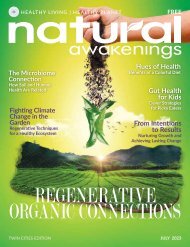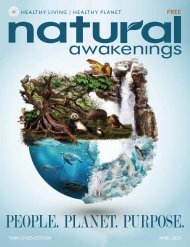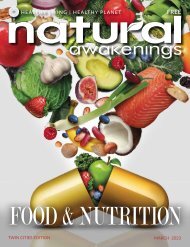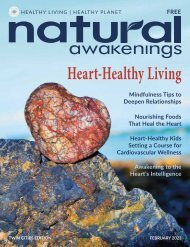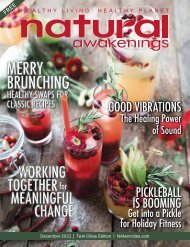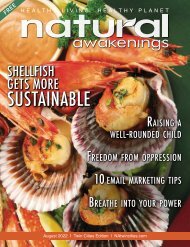Natural Awakenings Twin Cities February 2022
Read the February 2022 edition of Natural Awakenings Twin Cities magazine. This is our annual Heart-Centered Living Issue which is focused on minding the heart and heart and mind connection. This month we feature articles on living on the frequency of love, truly making love, sound of your heart determines your health, fermenting for foodies, parents as role models and so much more! Be sure to check out our local content including News Briefs announcements, Community Resource Guide with providers throughout the metro who can meet your individual wellness needs, and all the happenings in the Calendar of Events. There is additional online-only content that can be found at NATwinCities.com. While you are there, be sure to sign up for our Newsletter and Digital Magazine and continue your reading with our archived articles from local experts.
Read the February 2022 edition of Natural Awakenings Twin Cities magazine. This is our annual Heart-Centered Living Issue which is focused on minding the heart and heart and mind connection. This month we feature articles on living on the frequency of love, truly making love, sound of your heart determines your health, fermenting for foodies, parents as role models and so much more!
Be sure to check out our local content including News Briefs announcements, Community Resource Guide with providers throughout the metro who can meet your individual wellness needs, and all the happenings in the Calendar of Events. There is additional online-only content that can be found at NATwinCities.com.
While you are there, be sure to sign up for our Newsletter and Digital Magazine and continue your reading with our archived articles from local experts.
Create successful ePaper yourself
Turn your PDF publications into a flip-book with our unique Google optimized e-Paper software.
golden sikorka/AdobeStock.com<br />
kazakova maryia/AdobeStock.com<br />
Friendly Flights<br />
Airplanes Soar on the Power of Sunlight<br />
Carbon-neutral fuels are crucial for making air and sea<br />
transport sustainable. Aldo Steinfeld, professor of renewable<br />
energy sources at Eidgenössische Technische<br />
Hochschule Zürich, and a team of researchers have been<br />
operating a mini solar refinery for two years. He says,<br />
“This plant successfully demonstrates the technical<br />
feasibility of ... converting sunlight and<br />
ambient air into drop-in fuels. The system<br />
operates stably under real-world solar<br />
conditions and provides a unique platform for<br />
further research and development.” The technology<br />
is now ready for industrial application. The plant will be<br />
used to produce synthetic liquid fuels that release CO 2<br />
extracted<br />
directly from ambient air during their combustion<br />
using solar energy. The process yields syngas, a mixture<br />
of hydrogen and carbon monoxide, that can be processed<br />
into kerosene, methanol or other hydrocarbons.<br />
Johan Lilliestam, a research group leader at the Institute<br />
for Advanced Sustainability Studies and professor<br />
of energy policy at the University of Potsdam, explains,<br />
“Unlike with biofuels whose potential is limited due to<br />
the scarcity of agricultural land, this technology enables<br />
us to meet global demand for jet fuel by using less than 1<br />
percent of the world’s arid land, and would not compete<br />
with the production of food or livestock feed.” Given the<br />
high initial investment cost, solar fuels will need political<br />
support while the price of solar kerosene is high and production<br />
capacities are low. This would have little impact on<br />
the cost of flying, but would promote the construction of<br />
production facilities and lead to lower prices.<br />
Mucky Luck<br />
Peat’s Potential to Forestall Climate Change<br />
Super Shader<br />
Solar Canopies Green Urban Parking Lots<br />
When large collections of photovoltaic<br />
panels are erected as solar<br />
farms on undeveloped land,<br />
they can harm underlying<br />
ecosystems. As an<br />
alternative, large parking<br />
lots make use of land that is<br />
already cleared and produce electricity<br />
close to where it’s needed. Plus, they<br />
can also shade the cars. A solar parking<br />
facility at Rutgers University, in Piscataway,<br />
New Jersey, boasts an output of eight megawatts<br />
of electricity. If Walmart converted all 3,571 of its U.S.<br />
super center lots, the total capacity would be 11.1 gigawatts<br />
of solar power, roughly equivalent to a dozen, large,<br />
coal-fired power plants.<br />
Most solar installation presently occupy croplands, arid<br />
lands and grasslands, not rooftops or parking lots, according<br />
to a global inventory published in Nature. Building<br />
alternative power sources quickly is important to replace<br />
fossil fuels and avert catastrophic climate change, and<br />
the process is cheaper and easier to manage by building<br />
on undeveloped land than on rooftops or in parking lots.<br />
Ironically, putting solar facilities on undeveloped land is<br />
often not much better than building subdivisions there.<br />
Rebecca Hernandez, an ecologist at the University of<br />
California at Davis, notes that developers tend to bulldoze<br />
sites, removing all of the above-ground vegetation. That’s<br />
bad for insects and the birds that feed on them. The trend<br />
to cluster solar facilities in buffer zones around protected<br />
areas can confuse birds and other wildlife and complicate<br />
migratory corridors.<br />
Although peatlands are often disregarded as anaerobic wastelands, Christian Dunn, a wetlands scientist at Bangor University,<br />
in Wales, claims, “Peat is the superhero of the natural world.” Whether they are called moors, bogs, fens, mires,<br />
swamps or sloughs, the acidic, low-nutrient ecosystems are the most carbon-dense lands on the planet and can safely<br />
store twice as much carbon as all forests combined in one-tenth the landmass for 1,000 years. Climate scientists know<br />
the role oceans and forests play in storing carbon and are now coming to appreciate the power of peat and the need to<br />
preserve existing bogs and to restore those that have been damaged. On the flip side, carbon already locked up can be<br />
quickly released, hastening a warming climate. Because peatlands store an estimated 30 percent of sequestered carbon<br />
in 3 percent of the world’s land mass, climatologists call its potential discharge a “carbon bomb”.<br />
Human agricultural practices are at the heart of the problem, as about 15 percent of peat has already been<br />
lost worldwide. Farmers have been paid to convert peatlands<br />
with government tax breaks and cash subsidies. Indonesia,<br />
one of the world’s top five greenhouse gas emitters, is clearing<br />
peat for palm oil plantations, with farmers burning soil that can<br />
smolder for months. Britain, one of the first countries to focus<br />
on peat in in a strategy to reach net-zero emissions by 2050,<br />
has pledged more than $1 billion by 2025 on peat restoration,<br />
woodland creation and management.<br />
<strong>February</strong> <strong>2022</strong><br />
11





